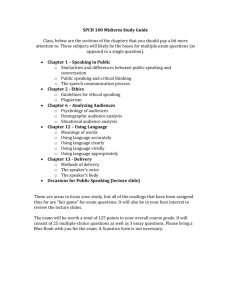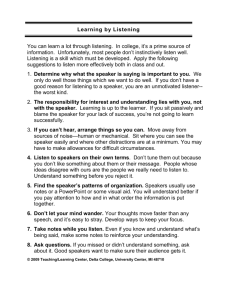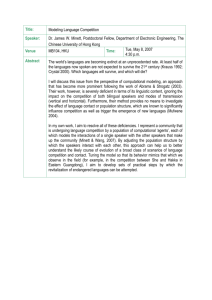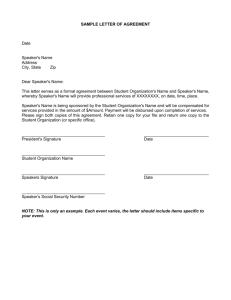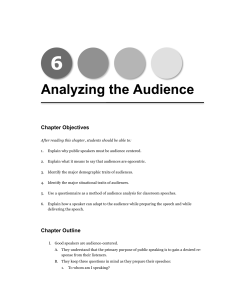Audience Analysis (4) & Research (6)
advertisement
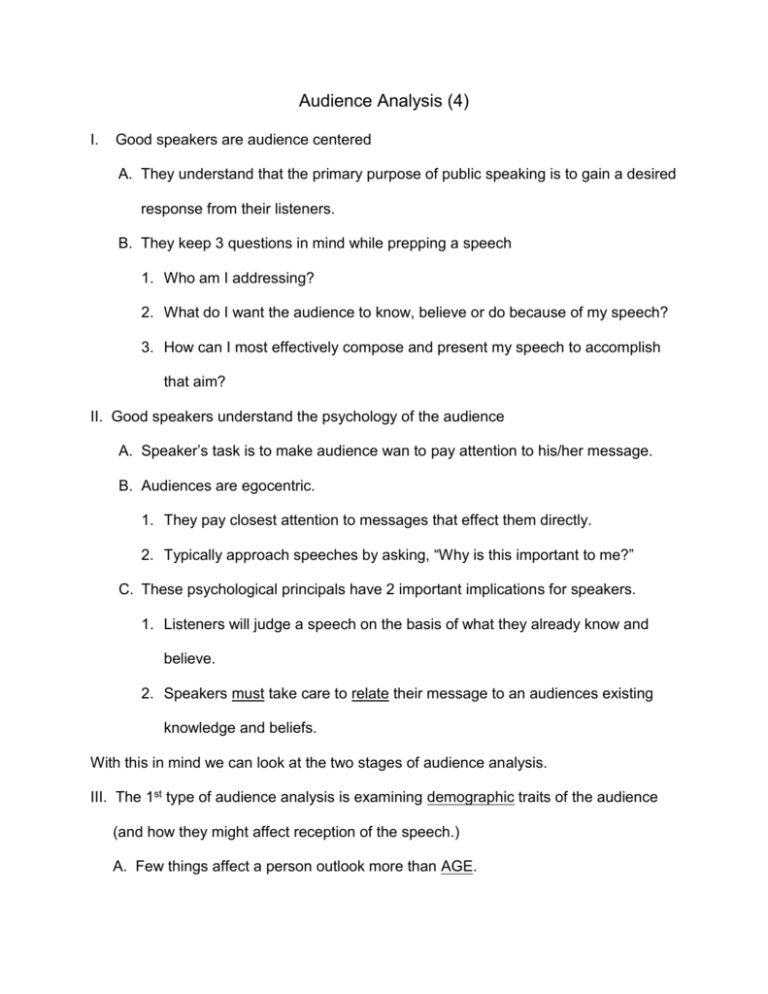
Audience Analysis (4) I. Good speakers are audience centered A. They understand that the primary purpose of public speaking is to gain a desired response from their listeners. B. They keep 3 questions in mind while prepping a speech 1. Who am I addressing? 2. What do I want the audience to know, believe or do because of my speech? 3. How can I most effectively compose and present my speech to accomplish that aim? II. Good speakers understand the psychology of the audience A. Speaker’s task is to make audience wan to pay attention to his/her message. B. Audiences are egocentric. 1. They pay closest attention to messages that effect them directly. 2. Typically approach speeches by asking, “Why is this important to me?” C. These psychological principals have 2 important implications for speakers. 1. Listeners will judge a speech on the basis of what they already know and believe. 2. Speakers must take care to relate their message to an audiences existing knowledge and beliefs. With this in mind we can look at the two stages of audience analysis. III. The 1st type of audience analysis is examining demographic traits of the audience (and how they might affect reception of the speech.) A. Few things affect a person outlook more than AGE. 1. Each generation has more-or-less common experiences and values. 2. Effective speakers adapt to these when addressing an audience. B. Gender issues can have a strong impact on how an audience responds to a speech. 1. Women and men in the U.S. share a broader range of experiences than they did (just) a few years ago. 2. The composition of audiences has also changed. a. Many audiences that were once predominately male now include large numbers of women and vice versa. C. It’s also important to consider the racial, ethnic, or cultural background of an audience. 1. Especial in U.S. because we’ve become such a multi-cultural, multi-racial society. 2. Every audience will have members of a different race or culture that influences their response to a speaker. D. The religious views of the audience need to be considered. 1. A speaker cannot assume the his/her views will be shared with all members of an audience. 2. Failure to consider this, can seriously weaken a speech. E. The group membership of an audience is another important factor (can provide valuable cues about their interest and attitudes.) IV. The 2nd type of audience analysis is examining the features of the audience unique to the speaking situation at hand. A. Size of audience. 1. Larger means more formal. 2. May effect language, how you use visual aids. B. Physical setting of the speech. 1. Size, seating and temperature of the room all effect how well listeners receive your message. C. Audience disposition toward the topic. 1. Speaker needs to assess the audience’s interest in the topic. – Normally, people won’t attend a speech if they aren’t interested in the topic – makes classroom environment more challenging. 2. Speaker needs to assess audience’s knowledge of topic. – If then need to be basic, if then can take a more advanced approach. 3. Speaker needs to assess audiences attitude toward topic – If skeptical, adapt. To be honest – each speech, each topic and each speaker needs to find the manner in which they can utilize and extend these BASIC guidelines to their advantage. Now that we’ve examined how to investigate an audience before speaking, we can progress to the next level and examine what we can do while we’re speaking. V. Adapting to your audience as you speak. A. A speaker usually has to depend on non-vocal cues. 1. Eye contact – the more the contact, the more their interested. 2. Facial expression a. Beware of frozen or non-responsive face. b. The “in-a-stupor) (slightly tilted head, faint smile, and often a hand holding up a chin) usually means daydreaming. 3. Restless movement. –fidgeting, … means lost interest. 4. Non-vocal responsiveness. – Head nods, respond when asked a question. Review Audience Analysis Looked at what it means to be audience centered, how to ID input aspects of and audience (both demographic and situational) before a speech, and finally what to look for during a speech.
